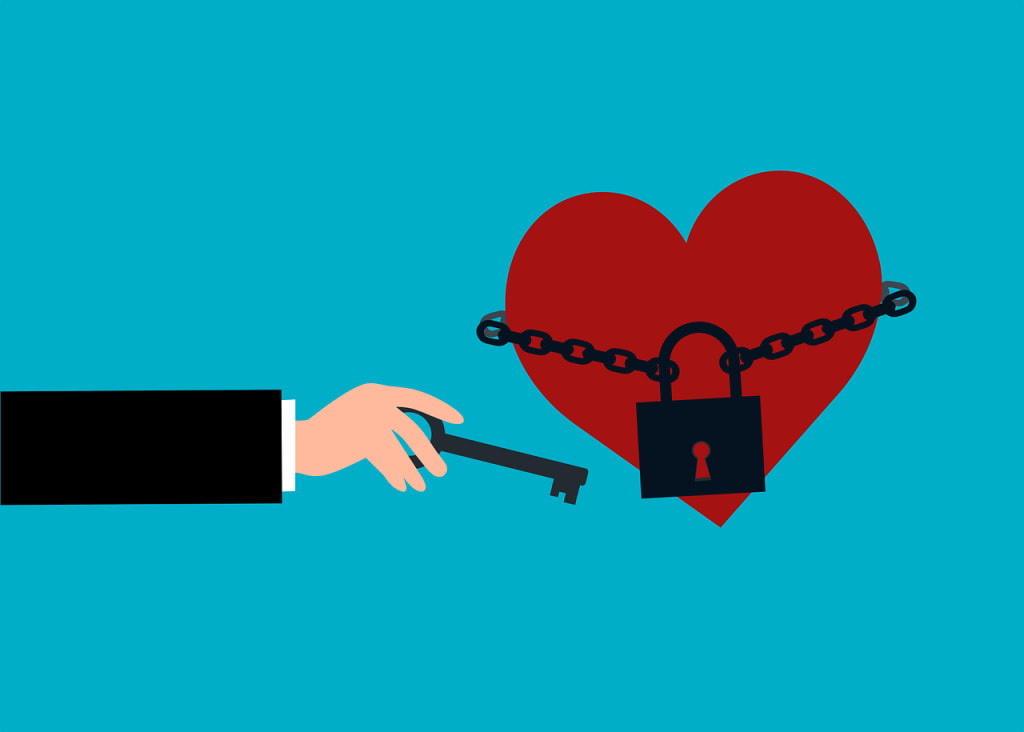5 Steps to Get an Emotionally Unavailable Man to Open Up
Here is how to get your partner to be more vulnerable

A man that is actively withholding his emotions in relationships is demonstrating a dismissive-avoidant attachment style. It’s important to remember that the dismissive-avoidant attachment style is an insecure attachment style, so they’re going to act disinterested, conceal their emotions, maintain distance, and be quick to withdraw, but these are all defense mechanisms. You’re ultimately dealing with someone who is likely more sensitive than normal, not less sensitive (as they pretend to be).
The mysteriousness and imperturbability of this personality can be very attractive. However, pursuing a dismissive-avoidant can also cause a lot of emotional distress. If you’re interested in them, then, for as long as those walls stay up, you’re likely going to be doing a lot of chasing to get very little back.
It can leave you constantly unsure of where you stand and feeling emotionally unfulfilled. Some might find it better to go look elsewhere altogether, but for those who believe they’ve found their person, and want to learn how to crack that hard outer shell, this is for you.
The 5 steps are: 1) be patient, 2) lead by example, 3) stay consistent, 4) avoid pitfalls, and 5) be ready for your opening.
1. Be Patient
The first thing is to be ready for the long haul. Remember, you’re dealing with someone who has been hurt before and is assuming that the moment they open up to you, you’re going to hurt them as well. It’s going to take a long while for them to trust you. Some might need to have a series of serious conversations, let a year’s time elapse, or even live with you before they really feel comfortable opening up.
You might feel dissuaded during this period and wonder when they’re going to open up to you, or if they’re really even interested. To get an answer to this you’re going to have to learn to recognize signals for communicating interest that might be dissimilar from your own.
Dismissive-avoidants tend to have silent love languages. It’s very hard for them to express their emotions verbally and directly, so look to the subtler languages, such as physical touch, quality time, and acts of service. Are they cuddling up with you and giving you hard hugs? Are they spending a lot of time with you? Do they seem to go out of their way to do things for you? Pay attention to these cues because these are basically their way of saying, “I really care about you.”
2. Lead by Example
Just like introverts tend to get adopted by extroverts because only extroverts are social enough to push their way into an introvert’s anti-social barrier, dismissive-avoidant types tend to end up with anxious-preoccupied people that are particularly needy. The anxious-preoccupied person heaps so much love on them, and is so aggressive in pursuing them, that the dismissive quickly lets their guard down.
It’s very hard to act this way if it’s not your natural inclination, but anyone can move toward it by degrees. All that really needs to be done is that you need to be willing to lead by example: Put yourself out there, and be vulnerable. The more you can show them that you care, the quicker they’ll develop trust that you’re not going to hurt them like the ones who came before.
3. Stay Consistent
This contains an element of patience in it, but it’s really just about maintaining a “brand.” The dismissive-avoidant is essentially the way they are because they’re constantly anticipating that you’re eventually going to switch up on them. That means that it’s critical that you maintain a consistent energy and persona towards them.
Moreover, baselines are very important in this relationship, like with any other. So if you initially come on strong, but you naturally lose some of that when you see it’s not being reciprocated how you would expect (because they’re concealing their feelings), and you then start holding back in turn, they’re going to feel like you’re losing interest and start withdrawing. It’s a marathon, not a sprint, so establish a baseline you can maintain.
4. Avoid Pitfalls
I hope that throughout the paragraphs above I’ve started to paint a picture of what exactly it is we’re navigating around with each of these steps: The dismissive-avoidant is hiding behind their castle walls, looking out for danger. We have to first be patient because we’re not going to draw them out in a day. We, then, have to try to overwhelm their defenses by meeting their indifference with love, until they feel like it’s safe to love back. And we have to remain consistent because they’re expecting us to be a Trojan horse, or a wolf in sheep’s clothing, and they’re waiting for any sign that things aren’t what they seem before they lower that rampart and let us in. In this context, what does it mean to avoid pitfalls?
They’re looking out for any signs of danger. That means you definitely don’t want to get caught in even a small lie. You don’t want to ever make yourself seem like the type of person who would hurt them or that isn’t strongly interested in them. Be very careful with bringing up stories of how you might have somewhat callously cut off all ties with someone you used to be in a relationship with. Be equally wary not to put them down in anyway with some backhanded compliment or accidental insult. Your goal is to make them feel safe. If you’ve done everything else, don’t undo your work by throwing out anything that, for them, will be a scary red flag.
I’d like to make clear here that I’m not arguing for anyone to deceive or manipulate the person they’re pursuing, but we all have rough edges and the dismissive-avoidant is ultimately very sensitive. We need to be mindful of how we present things. Even if it’s just an insignificant white lie, aim to always be honest instead. Better a painful truth than an easy-to-take lie. And even if we did something callous in the past, or happen to have left a broken heart or two in our wake due to circumstances beyond our control, we should present the story holistically, so that they can understand that we’re not just the type to hurt or disregard someone but that our actions were warranted.
5. Be Ready for Your Opening
In some ways, this is the most important step. If you’ve done everything else, and they’re genuinely interested in you, eventually it’s going to happen: They’re going to be vulnerable with you. It’s likely to be a small gesture. Maybe it’ll be some words with a little more feeling behind them or maybe communication that’s a little more direct than usual. Instead of “are you free,” it might be “I want to see you.” It could be a small gift that they surprise you with. It could be sharing something that’s important or personal to them that they wouldn’t share with just anyone. This is them dipping a toe in the water and inching out from behind those walls. This is do or die time, and so many people will drop the ball here. You need to treat them with kid gloves at this time, and reward them as much as possible.
The gesture itself is not important; it’s the act of vulnerability that’s everything. If you make them regret this act for whatever reason, you will have set yourself back farther than you can imagine. Do your damnedest to show them warmth, receptivity, and gratitude at times like this. It doesn’t have to be explicit; definitely don’t let them know that you know this is them finally opening up a little bit. But make sure you bring as much positivity to the interaction as you can for them. If it’s a personal story or revelation, stay present and engaged. If it’s a gift, muster every little bit of enthusiasm you can for it. If it’s an inkling of verbal affection, respond to it emphatically.
This, for them, was a test of the waters. It’s their first time letting you in and allowing you the opportunity to disregard their feelings for you. Of course, you want to make sure that’s the last thing you do. You’ve probably worked hard to get here, so make sure you don’t mess it up!
Conclusion
There’s really no such thing as dismissive-avoidant people. There are people who demonstrate a dismissive-avoidant attachment style because they’re actually very sensitive, loving people. This article is a guide on how to get them to drop those walls.
To review:
- You’re going to have to be patient. Rome wasn’t conquered in a day, and walls weren’t built to be lowered at the first sign of someone approaching them.
- Do what you can to lead by example. Be loving and vulnerable in a way they can’t, so you can reassure them of your feelings for them and show them that it’s safe to be the same way with you.
- Remain consistent. They’re expecting you to change up on them, so don’t do anything to make them think you might not be exactly who you seem to be.
- Avoid the easy mistakes. Don’t ever get caught in a small lie that can damage the already limited trust they have in newcomers to their life, and be careful with how you talk about them and your approach to relationships in general.
- Be ready for when they finally drop their guard! Dismissive-avoidants come out of their shells very slowly, and when they take that first step out, it’s a tiny one, but it paves the way for increasingly larger ones. Make sure you make each tiny step out a positive experience for them, so that they don’t withdraw and undo all the progress that was made up until that point.
All people have been hurt, and we all respond to that hurt differently. If you’re not dismissive-avoidant then this little manual might not apply to you, but I guarantee you another one can be written that does. We all need to be handled with care.
In the end, love is always worth it. If the person you love meets the description offered here, then hopefully this will help you get to that paradisal union we all so desperately want to reach.
Enjoy this article? If you have Amazon Prime, you might, for a short time, have access to the digital versions of my books for free. Click here to find out.
About the Creator
Martin Vidal
Author of A Guide for Ambitious People, Flower Garden, and On Authorship
martinvidal.co
martinvidal.medium.com
Instagram: @martinvidalofficial
Enjoyed the story? Support the Creator.
Subscribe for free to receive all their stories in your feed. You could also pledge your support or give them a one-off tip, letting them know you appreciate their work.






Comments
There are no comments for this story
Be the first to respond and start the conversation.